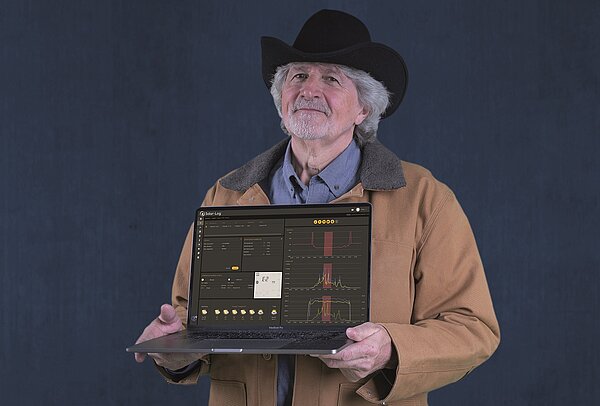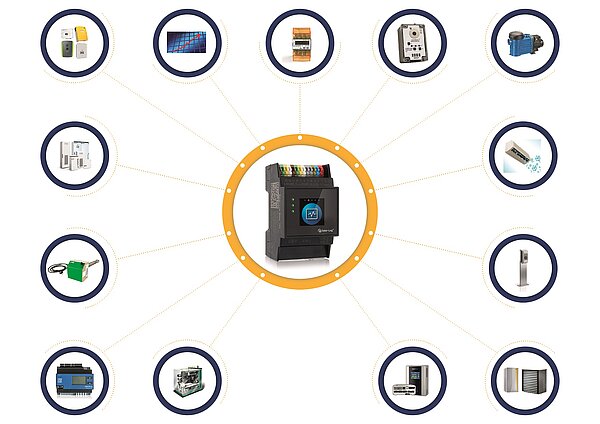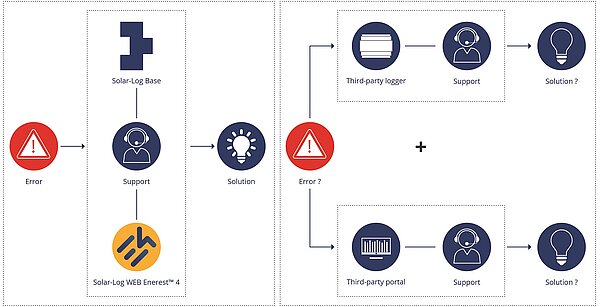PV monitoring systems in comparison
by Vivian Bullinger | 20.07.2022

The photovoltaic market offers numerous PV monitoring systems, some with very different solutions. From the all-rounder with data logger and software from a single source to the pure software solution, everything is available to the plant operator. The greatest differences can be found in the flexibility of the functions. However, these are usually hidden in the details, which is why it is worth taking a close look to find the right system.
What the market has to offer: around 50 PV monitoring systems
There are currently around 50 different PV monitoring systems on the market. These can basically be divided into three categories:
- Suppliers of data loggers and monitoring software
- Providers of pure monitoring software
- Monitoring software from inverter manufacturers
The data logger is the heart of the PV monitoring systems. It provides all the data from the PV system, which is then processed and output by the software.
In the case of providers of data loggers and monitoring software - so-called "complete solutions" - both components, i.e. hardware and software, are from one manufacturer. This has the great advantage that they are optimally matched to each other. In addition, PV monitoring is usually the core competence of these pure monitoring manufacturers, which enables them to provide the customer with a wide range of functions.
Providers of pure software solutions usually need a data logger from a third-party supplier. Here, a hurdle must be overcome right at the start; logger and software must be compatible. In the case of new functions or extensions, there are sometimes time delays because the developments are made by two manufacturers.
In the third category "monitoring solutions directly from the inverter manufacturer, one saves the data logger, because here the data is transmitted directly from the inverter. However, with this solution, you are limited to one manufacturer and cannot simply switch to another manufacturer later or flexibly expand the system as needed, since the inverter is the central element.
 Compact solutions offer software and hardware from one manufacturer. With Solar-Log™, software and hardware are also compatible with third-party systems from other manufacturers.
Compact solutions offer software and hardware from one manufacturer. With Solar-Log™, software and hardware are also compatible with third-party systems from other manufacturers.
What should PV monitoring systems be able to do?
PV monitoring has long involved more than just recording, reproducing and monitoring production data. When it comes to the scope of tasks for PV monitoring systems today, they must be able to do much more, including:
In addition to PV monitoring, the most important functions are own power use and feed-in management.
In-house power utilization means that the PV power is generated and used for in-house consumption. The monitoring system records the power consumption of the individual consumers and can thus contribute to optimizing the use of self-generated electricity. In some cases, it is already possible to control the consumers and storage units. For example, the battery storage is automatically charged when more of the company's own electricity is available than is being consumed.
Feed-in management takes place when all or part of the PV electricity is fed into the public grid. The monitoring system, which in this case is more of an energy management system, enables remote control of the PV system by the respective grid operator. In addition, the system records all data, including that of the regulation. If it is clear from the beginning that feed-in management is needed, it is recommended to choose a system that offers all components for this and regularly updates its system. This is because the market is very dynamic, especially in these areas, and constantly demands new functions.
The system owner should think carefully about how he wants to use his PV power. And if in doubt, choose a solution that can be individually expanded.
How flexible are the various solutions?
A lot has happened on the PV market in recent years. In addition to the complete solution providers, more and more providers of pure software solutions have come onto the scene. Many suppliers of complete solutions have reacted and now offer data loggers that are compatible with the software of other manufacturers.
Thus, the customer is free to choose the software solution and can change it as needed. However, one should pay attention to the contract terms here and take a close look at the respective functions. For example, direct marketing is usually not part of the service portfolio of the software solutions. And in the case of error analysis, you may also have to rely on the help of third parties, since this service does not have to be part of the portfolio. Another point is the contract terms - here it is worth taking a closer look. Prices may seem low, but then you are tied in for a long time and have to pay monthly installments.
Compared to software providers, with complete solutions - data logger and software from one manufacturer - you get a very flexible system. As a rule, the contract periods are very short or you do not have to commit yourself at all. However, the individual cost points must also be looked at in detail here, since the different manufacturers also form different systems. Mostly the systems are aligned to the requirements of the different plant sizes. A monitoring solution from a single source offers many interfaces and functions that are coordinated with each other. Thus one remains flexible also with possible extensions of the system. The solutions of the inverter manufacturers are well coordinated. However, one is not very flexible here, since with a manufacturer change or an extension one is always bound to the inverter manufacturer.
Many suppliers offer independent data loggers that are compatible with various software solutions. You should always pay attention to the contract terms and the range of functions.
 A system with many options for the use of PV energy. The PV monitoring systems should offer many interfaces to remain flexible in the future.
A system with many options for the use of PV energy. The PV monitoring systems should offer many interfaces to remain flexible in the future.
How quickly can innovations be implemented?
With the so-called "complete solutions", both the data logger and the software are optimally coordinated with each other. If, for example, the monitoring requirements are expanded, such changes are implemented at both interfaces in parallel. This means that there are no delays for the plant operator. If an update is available, it works immediately and there is no need to wait for a second manufacturer to implement the update. In other words, the data logger supplies the necessary data or the software can process new data.
Pure software solutions are often at a disadvantage here. They are dependent on the data supplied by the hardware (data logger) manufacturers. If the hardware provides new data, the software must first be adapted to it. In case of problems, e.g. after a firmware update, the user may experience long delays until the errors are corrected. With the solutions of the inverter manufacturers, one has everything from one manufacturer, as with the complete solutions. Here, new components only have to be purchased if required.
"Complete solutions" and the inverter solutions implement changes in parallel in the data logger and software. This means that there are no unnecessary delays.
What makes a good support?
Especially with technical systems, good support is indispensable. This is also true for PV monitoring systems. So it is always important to see whether the manufacturer offers customer support. Then there are various characteristics by which you can identify a good support service.
- What are the hours? From when to when is the support available.
- How can I reach the support? Are there different options here?
- Is there on-site support?
Often the error patterns are not clear. The more complex the system, the more difficult it is to assign the error, i.e. whether it is in the software or in the hardware or arises when the two systems are linked. With two different providers, there's no getting around having to talk to both support teams to find the cause. Which takes time and in turn can lead to a long troubleshooting process. The customer may act as a "go-between" here, as the knowledge levels of the two companies may differ and communication is more difficult. This inevitably results in long troubleshooting times and expenses for the customer.
With "complete solutions" and the inverter solutions, there is support for data loggers and software. This often saves time and is easy on the nerves.
 When hardware and software are from the same manufacturer, troubleshooting is usually easier and less time-consuming.
When hardware and software are from the same manufacturer, troubleshooting is usually easier and less time-consuming.
Where are the price differences?
Now it gets complex. There are tens of different pricing models. At first glance, the web solutions are the cheaper option. However, the costs for the data logger are always added here. In addition, you often have to commit to the manufacturer for several years due to long terms.
The complete solutions, on the other hand, usually have a higher entry price. On the other hand, you are usually less contractually bound - thanks to short terms. The services also differ greatly from one another in some cases. You should think carefully about what you need. And if in doubt, choose a system that can be flexibly expanded. That way, you only pay for what you need and can expand the functions as needed.
You also have to consider the flexibility of the different providers' pricing models. Because the energy market is not static. New requirements for PV systems are added on a regular basis. Even the change, for example, from self-consumption to direct marketing cannot be ruled out. Therefore, it is important to make sure that one is flexible with the respective energy management system and can change if necessary in order to profit from rising prices on the market.
Costs of the various PV monitoring systems must be closely examined. Not everything that is cheap at first glance is also cheap in the long run.
Back to the overview




